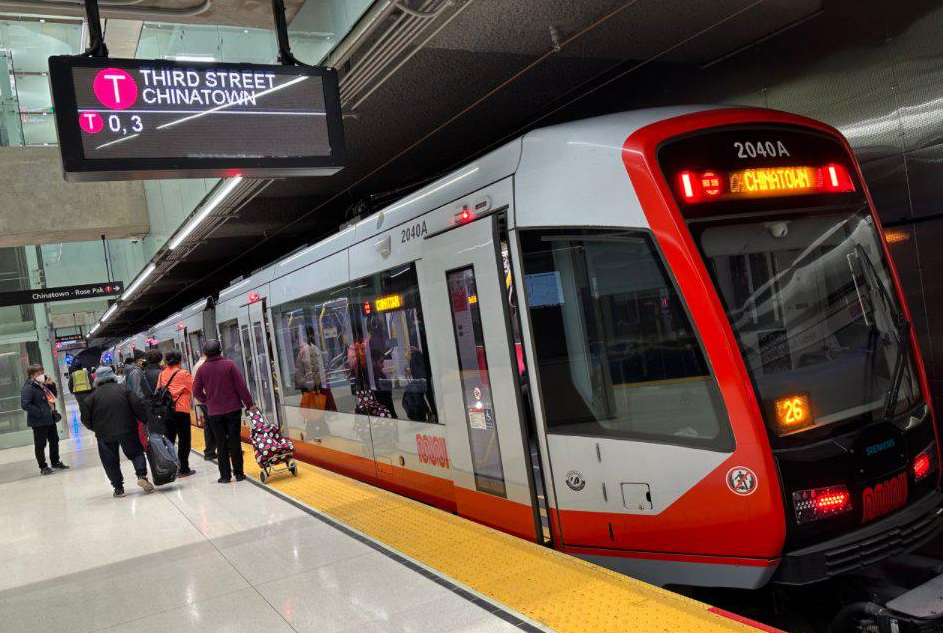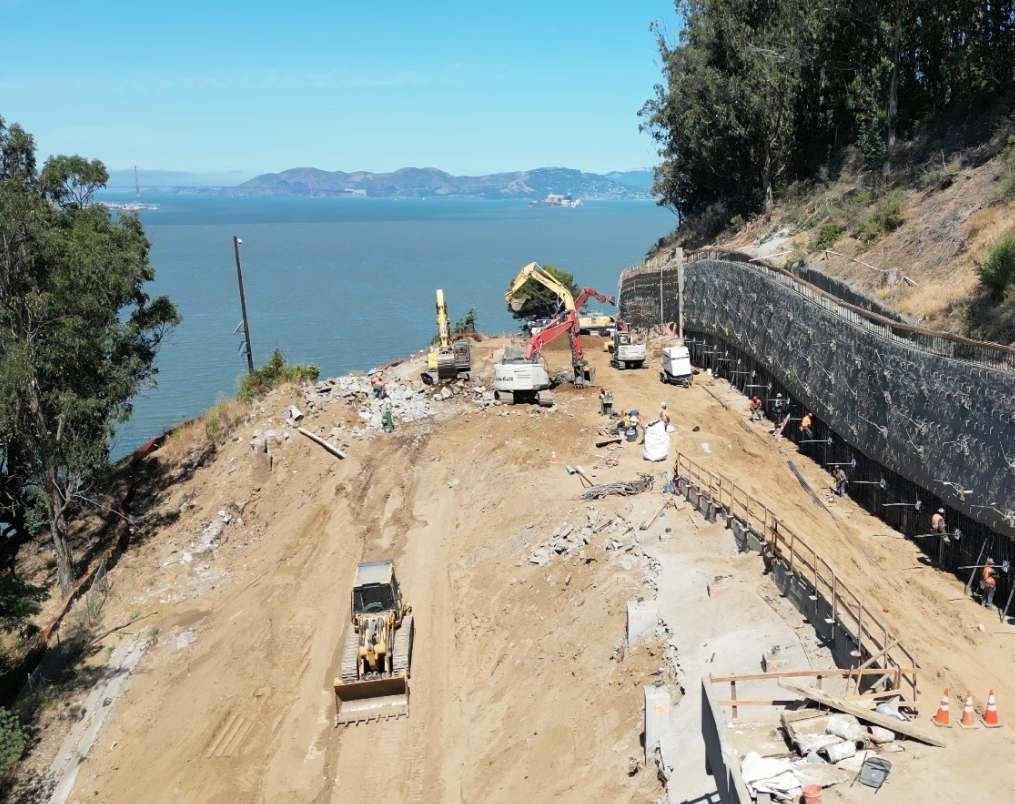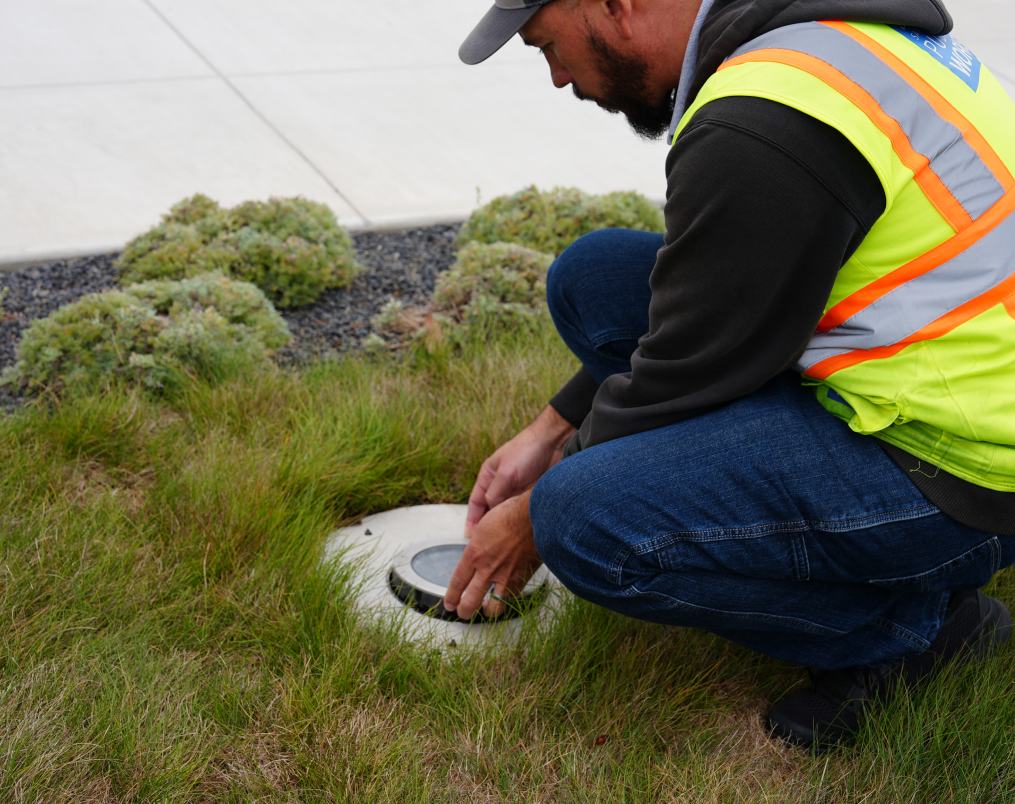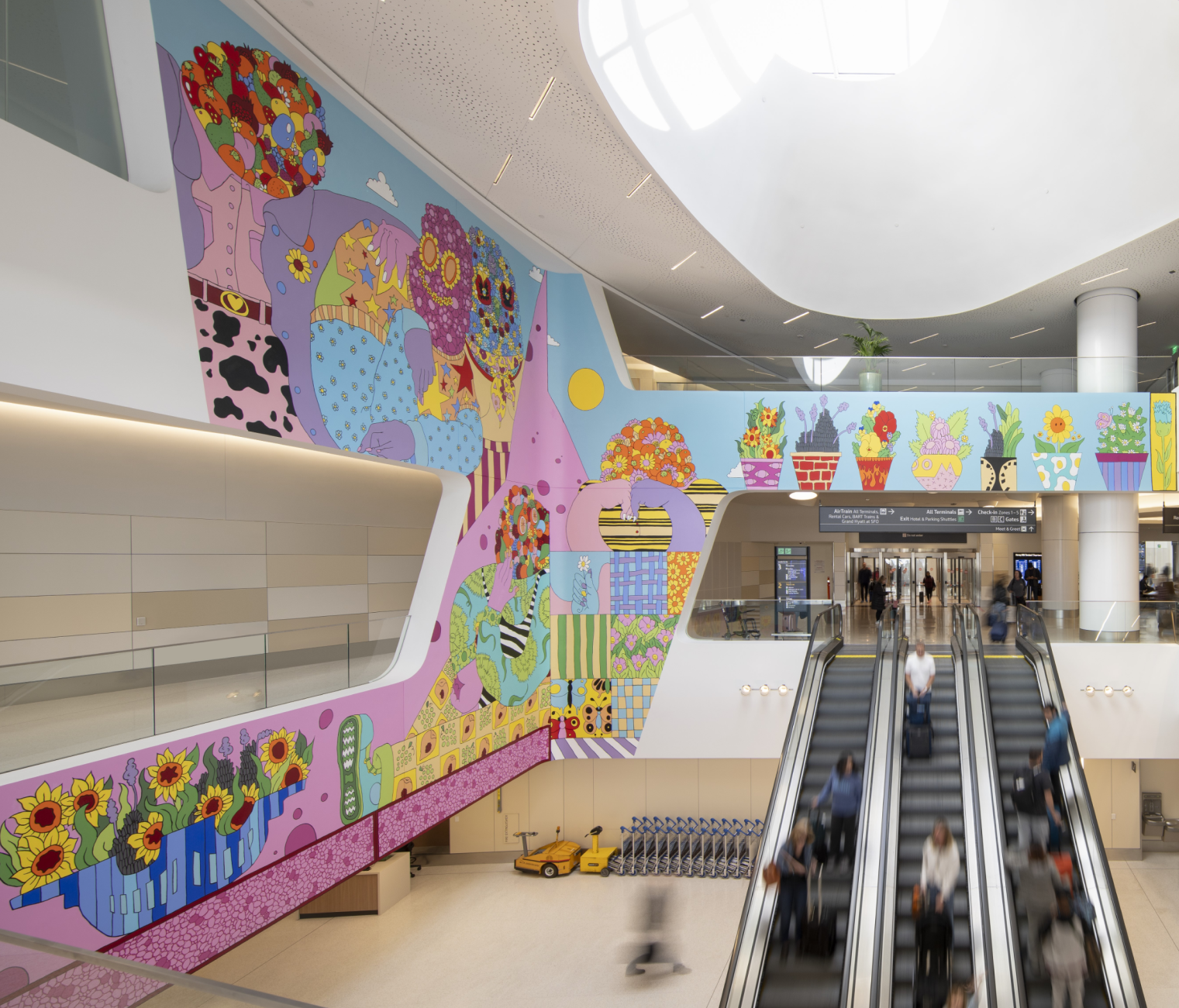SFO: San Francisco International Airport
PORT: Port of San Francisco
SFCTA: San Francisco County Transit Authority
Caltrain: Peninsula Corridor Joint Powers Board
TJPA: Transbay Joint Powers Authority
BART: San Francisco Bay Area Rapid Transit District

Investments in public transportation enhance the mobility of all residents and improve equitable access to workplaces, schools, essential services, and cultural and recreational activities. The COVID-19 pandemic underscored the important role that local, regional, and global transportation networks play in San Francisco’s economy and social fabric. Transportation will continue to be critical in the region’s economic recovery. In addition, in order to meet climate action goals of net-zero greenhouse gas emissions by 2040, action is needed to shift to less carbon intensive and efficient modes of transportation such as transit, bicycling and walking.
This chapter describes projects and programs to improve San Francisco’s transportation systems, mitigate losses due to the COVID-19 crisis, and build resilience in the sector over the next ten years. It is critical that San Francisco takes care of our transportation needs so that the city remains accessible and livable for generations to come.
Overview
San Francisco sits at the center of the Bay Area, both geographically and economically. To support residents, workers, and visitors, the City maintains a vast system of transportation infrastructure ranging from cross-town buses and Muni trains to the San Francisco International Airport, one of the busiest in the United States. Regional transportation assets, including Bay Area Rapid Transit (BART) and Caltrain, also run through the city, connecting San Francisco to the surrounding counties.
San Francisco is also in the midst of implementing several major capital initiatives that will improve its transportation system for years to come. From Better Market Street, bus rapid transit (BRT) lines on major thoroughfares, and terminal expansions at the Airport, San Francisco is adding capacity that will dramatically improve mobility.
San Francisco Municipal Transportation Agency
The San Francisco Municipal Transportation Agency (SFMTA) manages all City-owned ground transportation infrastructure. Related operations include running the San Francisco Municipal Railway (Muni), managing parking and traffic, facilitating bicycling and walking, regulating taxis, and planning and implementing strategic community-based projects to improve the transportation network and prepare for the future.
The SFMTA has a number of short-term and long-term processes in place to identify and prioritize its capital projects. Every two years the SFMTA develops its fiscally unconstrained Capital Plan, last published in 2023, to identify needs for capital projects and programs over the next 20 years. This Capital Plan is overseen by the Transportation Capital Committee, which is comprised of representatives from all the agency’s functional divisions. This identifies the agency’s capital investment needs and establishes priority investments.
Over the next ten years, the SFMTA’s total capital need is approximately $6.4 billion.
This chapter summarizes SFMTA’s capital needs at a high level. For a detailed description of SFMTA’s capital projects, please see the SFMTA’s published plans at SFMTA Reports and Documents.
San Francisco International Airport
As a department within the City and County of San Francisco, the San Francisco International Airport (SFO) manages a large and diverse infrastructure portfolio that includes four runways, 106 operational gates, and four terminals that total 5.7 million square feet.
SFO also oversees 32 miles of roadways, five public parking garages with several employee garages, the AirTrain transit system, a rental car facility, a 351-room hotel, leased cargo and maintenance facilities, a waste treatment plant, and more than 274 miles of pipelines, ducts, power, and pump stations for water, sewage, storm drainage, industrial waste, and gas, in addition to electrical and telecommunications distribution systems.
SFO staff periodically develop and update a plan for redevelopment, improvement, and expansion of SFO facilities. The plan is reviewed and approved by the Airport Commission. Currently, capital reporting and spending is tracked to the SFO Capital Improvement Plan (CIP) totaling $11.0 billion, which was approved in October 2023. The CIP consists of: (1) the $8.0 billion Ascent Program – Phase 1.5; and (2) the $3.0 billion Infrastructure Projects Plan, previously referred to as the Rolling Capital Improvement Plan, which addresses both current emerging needs and those related to replacement of aging infrastructure. A major objective of SFO’s current CIP is to position the Airport for projected passenger traffic growth and meeting demand-driven terminal gate needs. Other key CIP objectives include improving groundside access for passengers, enhancing safety and security, maintaining current assets in a state of good repair, promoting sustainability and resiliency, providing the information technology infrastructure necessary to meet passenger and tenant operational needs, improving the customer experience, and maintaining the Airport’s competitive position compared to other international gateways with respect to capacity and cost.
According to the U.S. Department of Transportation (DOT), SFO was ranked the thirteenth busiest airport in the United States in terms of enplaned passengers in FY2023, up from fourteenth in FY2022, and seventh in FY2019. It is one of three West Coast gateways, in addition to Los Angeles (LAX) and Seattle (SEA) international airports, that play an important strategic role in U.S. airline networks by providing access to markets in Asia and the South Pacific and facilitating connections to domestic and other international destinations. SFO remains the busiest airport in the Bay Area and Northern California and accounted for 63% of the total scheduled departing seats, domestic and international, at Bay Area airports in FY2023. SFO’s Capital Plan identifies $11.0 billion in infrastructure needs through FY2035.
This chapter contains a high-level summary of SFO’s capital needs. For a more in-depth description of capital projects, please see the five-year and 10-year Capital Plans published on the Airport’s website.
Port of San Francisco
The Port of San Francisco is the hub of the local and regional commuter, special event, and tourist water transportation network in the Bay Area. The Port constructs and provides land and water areas to support ferries and excursion vessels that are operated by external agencies such as the Water Emergency Transit Agency (WETA) and the Golden Gate Bridge and Ferry District. Though it does not operate any such vessels itself, the Port works in close collaboration with these critical agencies. The expansion of both publicly and privately operated ferries has reduced congestion in the Bay Area while continuing to build an emergency response network.
San Francisco County Transportation Authority
The San Francisco County Transportation Authority (SFCTA) is the sub-regional transportation planning and programming agency for the City. The SFCTA is responsible for the City’s long-range transportation planning, coordinating with federal, state, and other local transportation agencies. In this capacity, SFCTA helps to plan, fund, and deliver improvements for San Francisco's roadway and public transportation networks. The SFCTA is funded through a combination of local funds including San Francisco Sales Tax revenues, Vehicle Registration Fees, and a Transportation Network Company (TNC) Tax as well as grants from the State of California and the federal government.
Peninsula Corridor Joint Powers Board (Caltrain)
San Francisco, along with San Mateo and Santa Clara counties, is a representative member of the Peninsula Corridor Joint Powers Board (JPB), which operates and maintains Caltrain, one of the oldest commuter rail services on the west coast. Caltrain provides passenger rail service along the Peninsula rail corridor between San Francisco and Gilroy. Per the 1996 Joint Powers Agreement, funding for system-wide capital improvements is shared equally among the three member counties. Local improvements are, in general, borne by the county in which the improvements are located. More information on the JPB’s program of projects can be found in Caltrain Capital Improvement Plan (CIP).
Transbay Joint Powers Authority
The Transbay Joint Powers Authority (TJPA) was created to manage the financing, design, development, construction, and operation of the Transbay Program, including the Salesforce Transit Center and delivery of The Portal. Phase one of the Transbay Program included constructing the multimodal Salesforce Transit Center (Center), a $2.3 billion modern transit hub that replaces the seismically damaged terminal in downtown San Francisco.
Now complete, the Center helps to unify a fractured regional transportation network by connecting eight Bay Area counties and the State of California through 11 transit systems: AC Transit, BART, Caltrain, Golden Gate Transit, Greyhound, Muni, SamTrans, WestCAT Lynx, Amtrak, Paratransit, and the future California High-Speed Rail system. The project is split into two phases: Phase 1 saw the opening of the multimodal, multi-level Center in August 2018. Phase 2 encompasses (1) construction of The Portal, a 2.2 mile construction alignment with a new Fourth and Townsend Street Caltrain station, the Transit Center’s two-level train station including structures for emergency exit and ventilation along the tunnel alignment, (2) mainline trackwork through the tunnel and stations as well as at-grade trackwork tying into Caltrain's existing trackwork and rail systems, and (3) site work within Caltrain's railyards at Fourth and King Streets. In May 2024, the Federal Transit Administration (FTA) formally announced its acceptance of The Portal into the Engineering phase of the Capital Investment Grant (CIG) New Starts program and its commitment of $3.38 billion in CIG funding.
An important element of the Transbay Program, overseen by San Francisco’s Office of Community Investment and Infrastructure (OCII). The Transbay Redevelopment Plan has created a new mixed-use transit-oriented neighborhood surrounding the Transit Center with nearly 4,000 housing units to be completed, 35% of which are affordable. For more information on this neighborhood development, please refer to the Office of Community Infrastructure and Investment Section in the Economic and Neighborhood Development Chapter of this Plan.
San Francisco Bay Area Rapid Transit District
Since its opening in 1972, San Francisco Bay Area Rapid Transit District (BART) has become essential to the mobility, economy, and livability of the Bay Area for riders and non-riders alike. The rail system celebrated 50 years of service in 2022. BART links more than 20 Bay Area transit operators, serving as a transportation backbone of the region. Nearly 90% of all transfers using Clipper involve a leg on BART with about 400,000 transfers per month between BART and Muni (82% of Muni's inter-agency transfers).
Although BART’s ridership is currently 43% of pre-pandemic levels, BART continues to prioritize capital investments in existing assets, focusing on improving the reliability and safety of the system, while also making strategic investments to enhance the experience of riders and prepare for the future. The summary of BART’s planned capital investments detailed in this chapter represent San Francisco’s estimated share of the train system’s total Capital Investment Plan (CIP) through Fiscal Year 2035. San Francisco’s estimated share is based on number of stations, station exits, and train hours, and represents 27% of the total Capital Investment Plan. For more information on BART’s 10-year CIP, please visit BART Financials.
|

|

|


